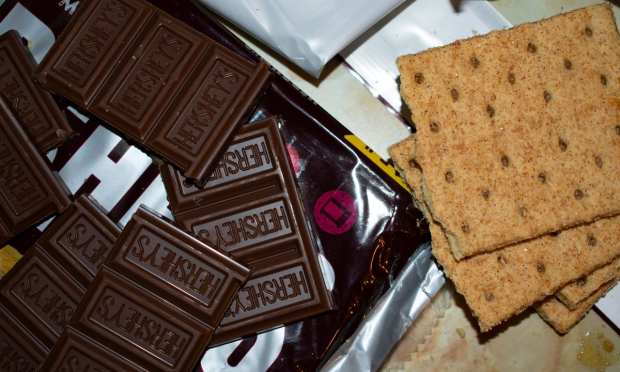CPG Brands Get Cozy With The Stay-At-Home Economy

There were a lot of superlatives associated with 2020, only a few them on the positive side. But there were some notable exceptions, including this one: It was the biggest year for s’mores in history.
That is what Hershey’s Chief Growth Officer Kristen Riggs said Thursday (Jan. 21) at a virtual conference hosted by the National Retail Federation as part of its keystone 2021 event. Riggs said consumers started bulking up on their Hershey bar supply a few weeks in advance of the normal Memorial Day sales explosion — and kept right on making marshmallowy treats en masse for the rest of the summer season.
Apparently, when the going gets tough, the tough make s’mores.
And Hershey’s, in the first instance of a new approach to its consumers, responded to the trend, ramping up production of the milk chocolate bars and the inventory at stores. It also adjusted marketing to depict s’mores as an ideal treat for a more intimate backyard celebration.
“Being able to read those consumer and retail signals quickly allowed us to take advantage of the opportunity,” she said, noting the company hopes to expand that opportunity by actively seeking to become a part of family movie nights, home baking projects and the movement of homebound consumers looking for a bit of “affordable indulgence.”
Moreover, she said, Hershey’s is increasingly joining the large contingent of consumer packaged goods (CPG) brands realizing their customer base now mostly hanging out around the house and eschewing physical commerce for its digital counterpart. In Hershey’s case, responding to those new consumer behavior signals, Riggs said, has meant getting savvier about online product placement — making sure Hershey’s syrup ads are placed near ice cream, or candy and baking supplies ads near Christmas ornament listings. It also means making the buying experience easier by, for example, making it possible for a customer to buy a collection of recipe ingredients with one click.
And Hershey’s is far from alone in making this adjustment or putting plans in place to enshrine its permanence, as evidenced by comments from a PepsiCo executive.
“What we’ve heard from consumers is that during times of crisis, they like to turn to things that give them comfort, and our brands play an incredibly important role in bringing smiles and joy and comfort to shoppers,” Jeff Swearingen, senior VP and head of PepsiCo’s Demand Accelerator, recently said in an interview. “We’ve seen that increase in demand for our products, particularly with salty snacks.”
Capitalizing on that need for salty snacks and comfort, Pepsi has taken the direct-to-consumer (D2C) route, rolling out D2C websites PantryShop.com and Snacks.com earlier this year, giving consumers an easy way to order the company’s popular food and beverage brands.
“The direct-to-consumer model [is] more of an attempt for us to stay closer to the consumer and read them — understand reaction to early innovation — and then obviously take it mainstream into the balance of the channels,” CEO Ramon Laguarta said on Pepsi’s latest earnings call. “It is still … very embryonic — [a] smaller percentage — but we’re getting good insights. And we plan to obviously scale them up a little bit and get better at reading consumers.”
Pepsi’s top rival, Coke, followed suit with a similar idea in early 2021, as meeting the digital consumers with a D2C option has become an increasingly popular option for big brands as the pandemic has worn on and consumer shopping habits have shifted.
Nike has also taken advantage of the D2C trend, with digital sales of its flagship brand and more than 100 percent digital sales growth in North America during the pandemic period. “We’ve now had three straight quarters of roughly 80 percent [worldwide] digital growth,” CEO John Donahoe, a former top eBay executive who took the helm at Nike in January, told analysts.
“This is the sharp point of our strategy. The consumer shift to digital is permanent, and our digital penetration will only increase in years to come. … We have a proven playbook, led by digital.”
Nike added that since the pandemic’s start the company has added 70 million new members globally.
And while megabrands have made the most headline-generating efforts, the moves among consumer brands to meet the stay-at-home consumer have been pervasive. Kimberly-Clark, which makes Cottonelle and Scott toilet paper, has been converting factories that produce office toilet paper into facilities that produce consumer paper, according to a Wall Street Journal report. Kraft Heinz, which makes Kraft Mac & Cheese cups and Oscar Mayer cold cuts, is spending $100 million to increase its eat-from-home lunch offerings next year.
Because though the end is in site — with a vaccine on the horizon — PYMNTS data indicates that even when the option to get back out there safely is present, a lot of consumers plan to stick with their digital habits. After surviving the challenges posed by the pandemic for all that time, 45 percent of consumers have shifted their retail shopping habits to digital, as have 21 percent of consumers who are shopping for groceries online and 21 percent of consumers who are buying food from restaurants via digital channels.
Consumers have embraced digital-first lifestyles nine months into the pandemic, the data indicates, and are less than likely to return back to their old ways of making day-to-day transactions. Of the 54.7 percent of respondents who are at least slightly likely to get vaccinated and who increased their shopping through mobile devices, only 21 percent plan to revert to the way they shopped before.
The digital shift has happened, and it seems brand like Hershey’s are getting the jump on writing what that new relationship will look like.
